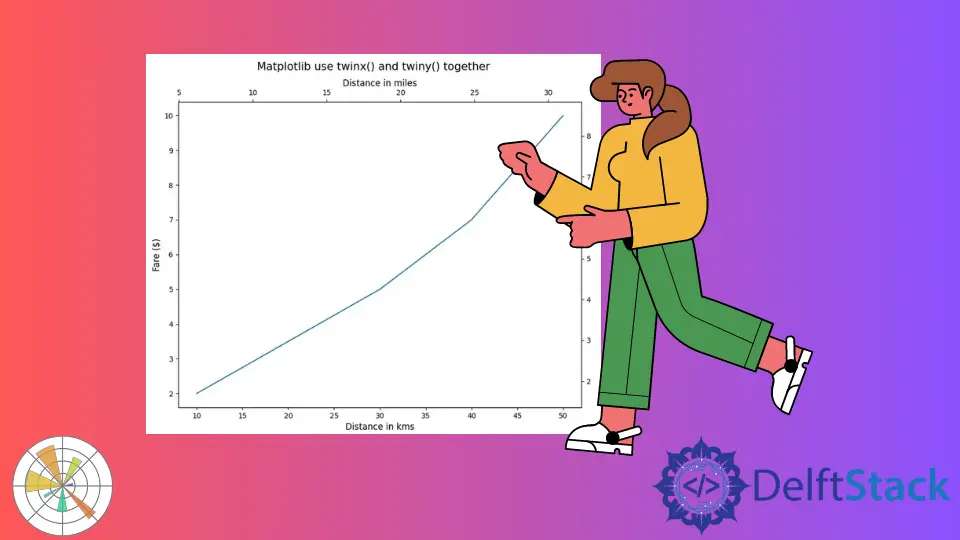Matplotlib 中的 twinx 和 twiny
Suraj Joshi
2024年2月15日
-
在 Python Matplotlib 中使用
matplotlib.axes.Axes.twinx() -
Matplotlib Python 中的
matplotlib.axes.Axes.twiny() -
Matplotlib 中一起使用
twinx()和twiny()

本教程介绍了我们如何在 Python Matplotlib 中使用 matplotlib.axes.Axes.twinx() 和 matplotlib.axes.Axes.twiny() 创建具有共同 X 轴或 Y 轴的双轴。
在 Python Matplotlib 中使用 matplotlib.axes.Axes.twinx()
函数 matplotlib.axes.Axes.twinx() 在 Matplotlib 图中创建与初始轴共享 X 轴的其他轴。
import matplotlib.pyplot as plt
students = ["Anil", "Sohit", "Hrishav", "Ayush", "Sunil"]
heights_in_cms = [165, 160, 140, 150, 130]
fig, axes = plt.subplots()
fig.set_size_inches(8, 6)
axes.bar(students, heights_in_cms)
y1, y2 = axes.get_ylim()
axes.set_xlabel("Students", fontsize=12)
axes.set_ylabel("Height in cms", fontsize=12)
twin_axes = axes.twinx()
twin_axes.set_ylim(y1 * 0.394, y2 * 0.394)
twin_axes.set_ylabel("Height in Inches", fontsize=12)
fig.suptitle("Plot using matplotlib.axes.Axes.twinx()", fontsize=15)
plt.show()
输出:
.webp)
它创建了一个学生身高的条形图。左边的 Y 轴标签代表学生的身高,单位是 cm,右边的 Y 轴标签代表学生的身高,单位是 inches。
在这种情况下,我们创建一个新的轴 twin_axes,与 axes 共享 X 轴。axes 的 Y 轴的标签设置为 Height in cms,而 twin_axes 的 Y 轴设置为 Height in Inches。
Matplotlib Python 中的 matplotlib.axes.Axes.twiny()
函数 matplotlib.axes.Axes.twiny() 在 Matplotlib 图中创建与初始轴共享 Y 轴的其他轴。
import matplotlib.pyplot as plt
distance_in_kms = [10, 20, 30, 40, 50]
fare_in_dollars = [2, 3.5, 5, 7, 10]
fig, axes = plt.subplots()
fig.set_size_inches(10, 8)
axes.plot(distance_in_kms, fare_in_dollars)
x1, x2 = axes.get_xlim()
axes.set_xlabel("Distance in kms", fontsize=12)
axes.set_ylabel("Fare ($)", fontsize=12)
twin_axes = axes.twiny()
twin_axes.set_xlim(x1 * 0.62, x2 * 0.62)
twin_axes.set_xlabel("Distance in miles", fontsize=12)
fig.suptitle("Plot using matplotlib.axes.Axes.twiny()", fontsize=15)
plt.show()
输出:
.webp)
我们创建一个新的轴 twin_axes,与 axes 共享 Y 轴。axes 的 X 轴的标签设置为 Distance in kms,而 twin_axes 的 X 轴设置为 Distance in miles。
Matplotlib 中一起使用 twinx() 和 twiny()
import matplotlib.pyplot as plt
distance_in_kms = [10, 20, 30, 40, 50]
fare_in_dollars = [2, 3.5, 5, 7, 10]
fig, axes = plt.subplots()
fig.set_size_inches(10, 8)
axes.plot(distance_in_kms, fare_in_dollars)
x1, x2 = axes.get_xlim()
y1, y2 = axes.get_ylim()
axes.set_xlabel("Distance in kms", fontsize=12)
axes.set_ylabel("Fare ($)", fontsize=12)
twin_axes = axes.twinx().twiny()
twin_axes.set_ylim(y1 * 0.85, y2 * 0.85)
twin_axes.set_ylabel("Fare in Euros", fontsize=12)
twin_axes.set_xlim(x1 * 0.62, x2 * 0.62)
twin_axes.set_xlabel("Distance in miles", fontsize=12)
fig.suptitle("Matplotlib use twinx() and twiny() together", fontsize=15)
plt.show()
输出:
-and-twiny()-together.webp)
它创建一个 Matplotlib 图,图的四边都有刻度线。axes'将控制左边的 X 轴和底部的 Y 轴,而 twin_axes’将控制右边的 X 轴和顶部的 Y 轴。
作者: Suraj Joshi
Suraj Joshi is a backend software engineer at Matrice.ai.
LinkedIn